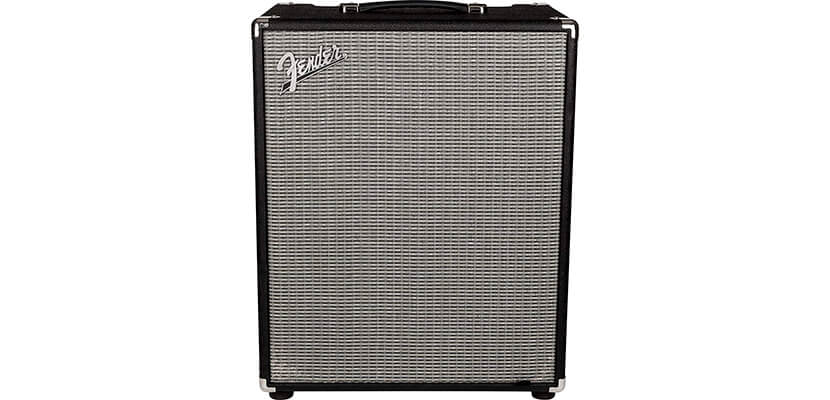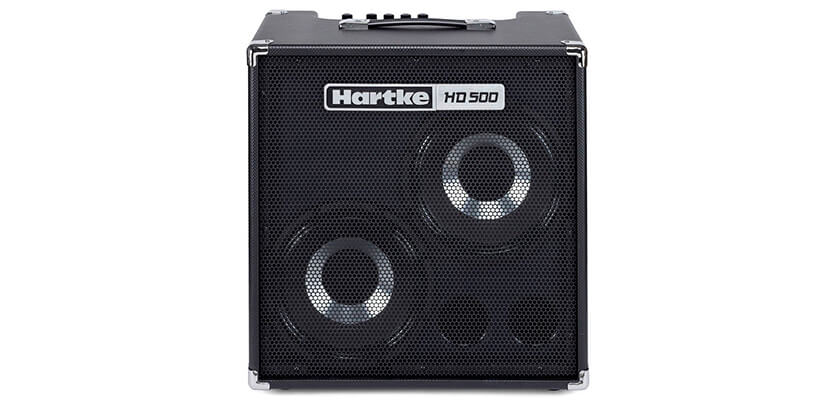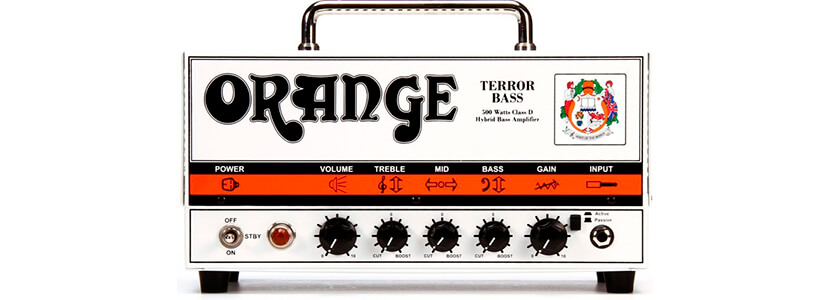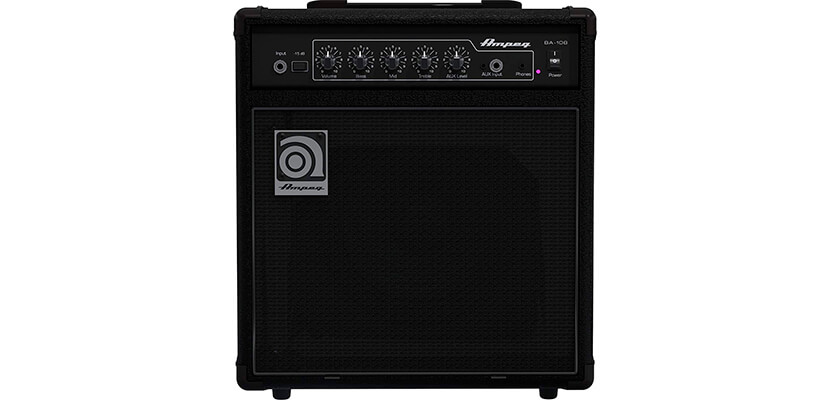If aiming to make the guitar sound both clear and powerful on the stage, the best bass amp is required. A bass guitar is not able to produce sound independently. The common guitar amp cannot capture the lower notes of the bass and when playing higher notes it will be distorted. However, if hooking it up to the bass amp, the guitar will fill the room with vibrations since this equipment is designed to handle a fat load without distortion.
The following reviews deal with both heads and combos that consist of a head and a cabinet. The latter is very convenient in case when the user has a cabinet but need to replace amp or vice versa. Besides, separate elements are easy to move around and to place them in different locations. Combos are great for beginners since there’s no need to make tons of adjustments. The product descriptions below also include amps with a wide range of power – from 100W and more. One can also choose between valve and transistor models.
Bass Amp Reviews
Fender Rumble 500 v3 Bass Combo Amplifier

The Fender Rumble produces 500W and it is loud enough for a small entry-level garage band to jam with a few friends subject to a controlled sound (sound systems or balancing volumes through the musicians’ individual amplifiers). This model is the most powerful among the Fender bass amps. It does the job for a band with drums and two or more guitar players in it. However, one can add an extension bass speaker cabinet to distribute the bass sound perfectly.
It’s possible to use it with the guitar but at low volume only since the speaker isn’t developed to handle the high frequencies of a guitar. The unit works great with a 5-string bass with a low B string. Sometimes, it might start screeching, but that’s not the equipment’s drawback. In this case, just turn down the treble on the bass. If that doesn’t work, turn down the treble in the amp. Make sure the overdrive switch is not engaged if being close to the amp.
The back of the bass amplifier is sealed, so there is no place to store the cord. However, the cord is removable to carry it separately. This model comes with one bass input, one AUX input, and one headphone output and a line out jack. The latter is a line-level out which is typically used for recording / PA or to slave into another amp. So, it’s possible to run the unit to effects, mixing board or to another amp’s input.
Pros
- The input can be used for a microphone to amp a voice.
- It does have a switchable overdrive circuit to work well with other pedals.
Cons
- The unit comes with the power cable, but no instrument wires are included.
- It doesn’t come with a footswitch.
Trace Elliot 3615760 Micro Amp Head Bass Guitar Electronics

If looking for a portable, powerful, and versatile bass amps, consider the Trace Elliot 3615760. This is a compact equipment with a sturdy case.
It produces a loud enough sound for gigs in small to medium-sized venues and features clear mids and highs. It handles active pickups well since the separate gain knob has a wide range to work with. Some bass guitars have active pickups that can be turned on and off. Note that volume is fading when turning in to passive that’s why it should be compensated.
Running it into 8 Ohms (120W output) provides enough sound but running it into 4 Ohms (200W output) makes the sound natural and extremely powerful even with a loud drummer. Too many mids that make the sound more even and a bit monotonous. It’s possible to solve the issue if having active basses – just turn the bass knob on the amp.
With regard to versatility, the amplifier works well both as a back up to a 500-watt bass amp for driving two cabs and the primary amp in the rehearsal studio.
Pros
- It comes with a small high-quality carry bag.
- This model features an XLR out to plug into your PA via mic cable.
- Good tone control.
Cons
- It takes pretty much time to work and understand the device’s power staging structure since its unique to this amp.
- The unit has the single ¼-inch output jack instead of the necessary ¼-inch combo jack.
EBS-RD750 Reidmar 750 Watt Micro-amplifier

The bass amp head features ICEpower 700ASC/X amplifier module – one of the most efficient and powerful class D modules. It’s based on the soft clip tech to save the definition of lows when the volume is at max.
The lightweight amp can be hooked up to a DJ controller backpack and produce powerful sound. It looks bulky cooperatively with other portable amps, but extra space provides a full-size front panel that results in large convenient knobs and readable texts.
Regardless of its light weight, this bass guitar amplifier is able to provide the signature tone – both clean and a bit distorted, dry, and full-bodied. Set the drive control at noon to liven up the tone without distortion and just play on the bass as usual for getting powerful and bright sound. The unit has clean DI on the amp that’s important for those who play into FOH systems.
The amp is remarkable for its functionality since it comes with a good I/O section with two sockets for remote toggling of the character, drive, filter, and mute functions.
Pros
- Sockets for headphones and for connecting with the external audio source.
- Great volume capability ensures loud sound even for the stage where reinforcement via monitors isn’t accessible.
- It comes with an effective compressor and powerful drive control.
Cons
- The mute option is not available remotely but via footswitch only.
Hartke HD500-Bass Combo (HMHD500)

This bass guitar amp has a solid-state preamp and a lightweight Class D power amp. It features a lot of power for the gigging bass player. Its two 10-inch HyDrive speakers provide clean sound. They are made of both paper and aluminum to produce warm, round tones with dynamic upper mids and highs. Besides, the sound is extremely loud and boasts well-controlled lows even at max.
The 3-band equalization on the top-mounted control panel makes it possible to adopt sound for any music genre. One can widen the frequency range with just one press of a button if using selectable Shape control. It sweeps from 100Hz to 900HZ and changes the bass tonal color if desired.
The Hartke bass amp comes with the XLR direct output for direct connection with the sound system or recording chain. Those who need privacy will be glad to see the headphone jack since the speaker output is disabled. The AUX input accepts signals from the mp3 player, CD player, and other external devices to jam along with backing tracks.
Pros
- The unit is convenient for tours. It’s so lightweight (35 pounds) and shallow in depth that there is no need for casters. Besides, it comes with a single strap handle.
- This equipment works well with both active and passive instruments.
Cons
- No tweeter to balance the sound.
- Sometimes, its tone might feel too compressed.
TC Electronic BH250 250 Watt Micro Bass Head

The BH250 is a lightweight and portable device with a built-in tuner. It features powerful and clean sound without unwanted noise and it is loud enough for practices and small rooms.
Though 4 Ohms is listed as the minimum, this amp works with an 8 Ohms speaker cabinet too. The EQ provides a lot of tone control and the preamp boost for the passive bass. The tone print feature while playing through the pickups allows doing it with a tone of pedal sounds. So, the musician doesn’t need pedals and the onboard tuner even for 5 and 6-string bass. Note that the USB connection for uploading tone prints doesn’t work for Mac Book Pro, but it’s relevant to the iPhone. Besides, TonePrint editor is compatible with only the pedals but not the bass amps.
The bass guitar amp comes with the external speaker outlets to hook up speakers to this amp. There are AUX output and a plug for headphones on the front panel for late-night practice. It’s possible to use booth the DI as the main output (it sounds punchy and creamy) and the speaker output as a monitor.
Pros
- The unit is very quiet. One can play it even in a small bedroom and the fan won’t be disturbing.
- The mute switch is perfect for the tuning part of the head.
Cons
- The unit lacks quarter-inch outputs that’s why it’s necessary to use a Speakon-to-quarter-inch adaptor to plug a quarter-inch speaker cable.
- The line-in can’t be equalized since the amps aren’t designed for this purpose.
Orange Terror Bass 500-Watt Bass Head

This acoustic bass amp is a single-channel circuit housed in white powder-coated chassis. The device is light enough to carry it in one hand. It’s rather sturdy due to the strong metal chassis and a handle. The power knob has a “Standby” that comes in handy if a dedicated “Mute” switch is absent.
The unit provides a punchy and huge sound. It comes with a 3-band EQ section onboard for bass, mid, and treble controls. A mini-toggle next to it allows getting a dirty tone for rock/metal and switch it to clean it up nicely for blues or jazz. It’s designed to deliver headroom and smooth tones.
The unit comes with a tube preamp – with both a 12AT7 and 12AX7 installed. It adds depth and sweetness to the sound that makes a bass with a whole tone scale. The quarter-inch instrument input and a 6 dB pad switch for active basses are also on the front panel. The Speakon connectors to hook up speakers are on the rear panel. The unit’s impedance allows both 4 and 8-Ohms connections.
Pros
- A cooling fan isn’t intrusively loud.
- The controls on the front are clearly marked.
Cons
- The amp falls short of Hi-Fi quality.
Ampeg BA108V2 20-Watt 8″ Bass Combo Amplifier

If being lost in the variety of bass amp brands, give attention to the Ampeg BA108V2 with two AUX inputs and a headphone input to play along with a track from the phone or turntable without disturbing other people. It’s a wide choice to practice in a small room or studio space. It comes without a distortion channel, but there is a -15DB pad to attenuate active basses. The amp sounds nice and full at very low volumes.
Technically, it can be used with both the electric guitar and drums. However, the size of the speaker probably couldn’t handle the kick drum. This instrument needs a larger speaker (12-inch or 15-inch) and higher wattage output.
This combo features durable construction with high-quality and well-marked control knobs that are heavy enough to feel solid when they’re turned.
Pros
- It’s very easy to find the wanted tones.
- The combo is designed to set it on the side and use it as a wedge loudspeaker.
Cons
- It lacks line out to record directly from the amp.
- No opportunity to use a mic and guitar simultaneously with one amp. It’s possible to mic the amp through the primary PA system.
What Bass Amp Should I Get?
Even one of the top bass amps might prove unhelpful if getting it at random. The first thing to consider is the purpose of use – whether it is about rehearsals, practice, small gigs, or professional performing on the stage. In the first cases, a cheaper unit with modest power up to 100W will be suitable. However, if speaking of stage experience or even rehearsals with several guitars and drums in large spaces, lots of power is required.
The musicians’ lifestyle is also meaningful. It’s better to acquire heads rather than combos for tours since they are lightweight and portable. To that end, the models with switchable power supply are helpful as it allows plugging the amp into any power supply without using a special converter.
Besides, consider the level of skills since the novices might fail to cope with connecting heads and cabinets together and making proper setups. What other factors are important to bear in mind?
- The built-in tuner is a great assistant since it comes with the displays and allows making silent and discreet adjustment during performing.
- Two-channel amps come with one channel for clean sound and the other – for distorted one. This tech allows toggling between those setups fast while the song is playing or between two of them. It comes in handy when, for example, the song requires a clean-tone intro and a distorted main part.
- A number of tone controls to adjust the whole range of frequencies. For example, some models feature a bright switch to make the sound clearer. Other amps come with contour and shape circuits or have EQ setups to adopt sound for the specific music genre.
- Resonance and damping controls are responsible for the speakers’ performance. They make the outgoing sound more focused and tighter.
The good bass amps have preamps with plenty of connections. The line-level out makes the recording / PA and the extra connection with other equipment possible. Though a cabinet cannot be driven directly with it, it allows running the line out to a power amp that, in its turn, would drive extra cabinets. The other useful ins and outs:
- Jack In to plug the bass or doubled input to connect both passive and active instruments.
- Headphone out to practice at home or at night.
- RCA to connect the amp to a computer and players.
- Direct out (XLR) to hook the amp up to a recorder or mixing console.
- Effects Loop for more tonal control of the amplifier.
The following recommendations correspond to the combos. Sometimes, the customers worry about speakers’ size, but the latest amps are able to reinforce low-frequency response in a properly designed small cabinet.
Generally, it’s a matter of either individual taste or music genre. Some people just prefer one or two large speakers while others like several small speakers in one cabinet regardless of the music they play. Many bassists claim that small speakers are punchier and they’re perfect for playing rock and funk. They consider large speakers more suitable for jazz and amplifying acoustic basses since they provide round and rich bass.
The cabinet’s design is more important than the speaker’s size for getting a great sound. Bass amps’ cabinets should be sealed or ported to produce all the frequencies precisely. The cabinet’s construction is also crucial since only solid units can withstand strong vibrations. Well-braced combos exclude rattles, buzzes, and resonance. It’s great if the speaker’s cabinet comes with vents to enhance its efficiency.
So to choose the best bass amp (whether it is about a head or a combo), one should think of where and what to play, what equipment it is planning to connect and what setups are necessary to adjust.

Hi everyone! I’m Thomas Moody, also known as Guitarzan.
